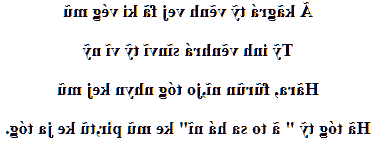Kaingang love poem
Ki vẽnh vej fã
à kãgrá tỹ vẽnh vej fã ki vég mũ
Tỹ inh vẽnhrá sĩnvĩ tỹ vĩ nỹ
Hãra, fũrũn nĩ,jo tóg nhyn kej mũ
Hã tóg tỹ " ã to sa há nĩ" ke mũ pir,tũ ke ja tóg.
Professor, à EscolaFág Kavá


→ French poem ←
Kaingáng language
Here is the translation into Kaingang (Caingangue, Kaigang, Kaingáng, Kainjgang, Coroados, Bugre, Caingang, Coroado, autonym: Kanhgág) of my little poem.
Caingangue is a southern Gê (Jê) language which count approximately 20,000 speakers. The Xokleng in Santa Catarina, even if it is very close and has the same origin... is to be differentiated!
This translation is in the language of the Kaingang indigenous of Brazil, exactly, in the southwestern dialect variant, is that of the Indians of Terra índigena Serrinha Ronda Alta, Rio Grande do Sul.
The other four dialects are those of:
- the southeast (Rio Uruguay (RS) and Rio Passo Fundo (RS)),
- the center (between the Rios Uruguay (RS) and Iguaçu (PR)),
- São Paulo (paulista, considered the most divergent) (north of the Rio Paranapanema (SP)),
- and that of Paraná between the Rios Paranapanema (SP) and Iguaçu (PR).
The contacts between the different groups ended up "establishing" Paraná as the variant considered as the reference.
Although Kaingáng is one of Brazil's native languages with the most speakers, it is considered endangered.
Indeed, bilingualism with Portuguese is gradually tending to abandon Kaigang, and currently the São Paulo dialect is by far the most affected.
In the communities, this bilingualism supported by bilingual education, with Portuguese learning, in the face of a devalued Caingangue has accelerated the abandonment of their language by the youngest.
Kaingang people
The first contacts between Kaingangs and Portuguese date from the beginning of the 19th century (Guarapuava).
After wars and extreme violence with the settlers (coffee), the priests came to evangelize them. They are the ones who made the first studies concerning their language.. Today the studies have been thoroughly studied.
Colonization drastically reduced their number (they were only 4,000 in the 1950s), and pushed them into reserves, where they were assigned.
The Coroados to which they have often been assimilated because of their crown of feathers on the head, are in fact to be differentiated. If they formed the same people a long time ago, today the differences are notable.
Among the Kaingangs, whose society is patrilineal, the world is divided into two kamé and kairu. Beings and things belong to one or the other half.
Today, pushed back by the settlers, they live in 48 indigenous lands (reservations), mostly in Rio Grande do Sul and Paraná.
In addition to small agricultural production (rice, soybeans, corn, beans), hunting, fishing and gathering, they often serve as cheap labor for the settlers who are near their reserves.
